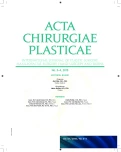A-10 Reconstruction of traumatic defects of distal third of the calf with a fasciocutaneous sural flap – our experience
Authors:
I. Slaninka; A. Fibír; R. Čáp; L. Klein; F. Hošek; L. Hasenöhrlová; A. Bajus; O. Šedivý
Authors‘ workplace:
Department of Plastic and Aesthetic Surgery and Burns, Department of Surgery, Medical Faculty, Charles University and University Hospital Hradec Králové, Czech Republic
Published in:
ACTA CHIRURGIAE PLASTICAE, 57, 3-4, 2015, pp. 60-61
Category:
Selected abstracts from the 36th national congress of the czech society plastic surgery with international participation
Large defects in the area of the ankle, foot and distal third of the calf are often difficult to treat due to limited reconstruction possibilities. In indicated cases is the reconstructive method of choice usage of a free flap. Despite clear advantages of microsurgical therapy is reconstruction with a local or pedicled flap within these indications less frequently used, yet it is a reliable therapeutic modality. This method is mainly suitable in patients contraindicated for microsurgical procedure or in case of multiple injuries or polytrauma, where the speed of operation and subsequent recovery is important for the patient. During the last 3 years we performed totally 7 reconstructions using the sural flap. This is a reverse venofasciocutaneous flap, the arterial supply of which is provided by fasciocutaneous perforators from the peroneal artery and tibialis posterior artery, venocutaneous perforators from the lesser saphenous vein and neurocutaneous perforators from the sural nerve. Venous outflow is provided by collateral veins of the lesser saphenous vein, since this vein contains valves, which under normal conditions disable backflow of venous blood. Therefore the flap is susceptible to venostasis, mainly in younger patients, who still have these valves sufficient.
Our presentation shows experience with the use of this flap. We think that the sural flap offers a wide arc of rotation, constant vascularity, simple and rapid elevation with acceptable morbidity of the donor site. The disadvantage may be considered the secondary morbidity of the donor site with skin graft character at the site of harvested skin island and also sensitive loss in innervation zone of sural nerve. Sensitive deficit may be reduced or eliminated, if sural nerve is left in situ in the proximal part up to the area, where it passes through fascia superficially. This area is usually approx. 10-12 cm proximally from the apex of the lateral ankle and therefore must reach to the proximal shift of the pivot point. Disadvantage in this case is shortening of the arc of possible rotation in this case. In some cases is sural nerve sometimes duplicated and sensitive deficit during the use of this flap is not so great. From the practical point of view, it is necessary to pay greater attention to possible flap venostasis, which could significantly impair the overall nutrition of the flap. Therefore, we do not recommend passing the pedicle through a subcutaneous tunnel to the site of the defect or suturing of skin cover over the flap pedicle, which is best to be transplanted completely with split thickness skin graft. (Fig. 10.1, 10.2, 10.3.)

Sources
1. Follmar KE, Baccarani A, Baumeister SP, Levin LS, Erdmann D. The distally based sural flap. Plast Reconstr Surg. 2007 May;119(6):138e–148e.
2. Ignatiadis IA, et al. The reverse sural fasciocutaneous flap for the treatment of traumatic, infectious or diabetic foot and ankle wounds: A retrospective review of 16 patients. Diabet Foot Ankle. 2011;2. doi: 10.3402/dfa.v2i0.5653. Epub 2011 Jan 12.
3. Mojallal A1, Wong C, Shipkov C, Bailey S, Rohrich RJ, Saint-Cyr M, Brown SA. Vascular supply of the distally based superficial sural artery flap: surgical safe zones based on component analysis using three-dimensional computed tomographic angiography. Plast Reconstr Surg. 2010 Oct;126(4):1240–52.
Labels
Plastic surgery Orthopaedics Burns medicine TraumatologyArticle was published in
Acta chirurgiae plasticae

2015 Issue 3-4
- Metamizole vs. Tramadol in Postoperative Analgesia
- Metamizole at a Glance and in Practice – Effective Non-Opioid Analgesic for All Ages
- Metamizole in the Treatment of Acute Postoperative Pain
- Possibilities of Using Metamizole in the Treatment of Acute Primary Headaches
- Spasmolytic Effect of Metamizole
Most read in this issue
- 36th NATIONAL CONGRESS OF THE CZECH SOCIETY OF PLASTIC SURGERY WITH INTERNATIONAL PARTICIPATION
-
ZORA JANŽEKOVIČ
(September 30, 1918 – March 17, 2015) - Dorsoradial forearm flap with silicone bone spacer in reconstruction of A combined THUMB injury – case report
- Editorial


